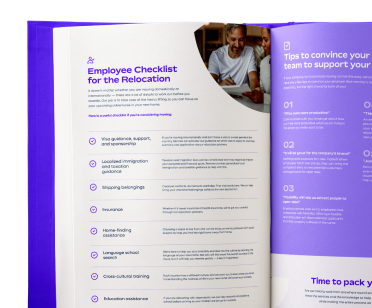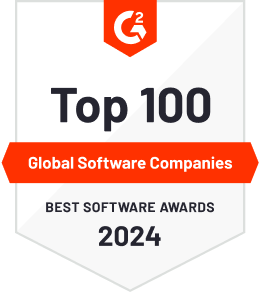
Product Updates — 7 min

Visas and Work Permits — 10 min
Whether you’re hiring an employee in the US or relocating an existing employee to the country, you’ll have to make sure they have the correct paperwork to work there legally.
The United States has a range of options for employers looking to hire international workers, from temporary work visas to permanent residency for highly skilled workers. However, navigating the world of work visas and permits in the US can be tricky, especially if you have limited knowledge of US state and federal laws.
This guide will walk you through the basics of work permits and visas in the US and explain the steps you need to take if you want a sponsor a team member’s visa in the US.
The US is one of the most desirable countries in the world for workers and businesses, but its work permit and visa requirements can be broad and complex. The US government takes violations of its immigration laws seriously, so you must make sure your workers have the right visa and other documentation.
Employees may face severe penalties, including fines, imprisonment, and deportation if found to be working without the correct US visa. Additionally, working on a tourist visa is often illegal in the US. As remote work and the digital nomad lifestyle become more popular, governments are starting to enforce this legislation more strictly.
US citizens are eligible to work unrestricted in the country, even if they are currently living abroad. Permanent residents must provide proof of their eligibility to work in the US, such as a Permanent Resident Card (PRC, also known as a ‘Green Card’).
However, if your employee is not a US citizen or permanent resident (i.e., they are a non-citizen), they will need to acquire permission to work in the US.
Here’s what you need to do to get that permission.
It’s important to first note that work permits and visas are not the same thing.
In the US, a work permit is known as an Employment Authorization Document (EAD), and it authorizes the recipient to work in the US for any employer. It is not a travel document.
A visa, meanwhile, allows the recipient to physically enter the US (and re-enter if they leave). Many types of visas are granted based on the recipient’s proposed activities, such as studying, working, seeking asylum, or doing business. In this instance, we will focus only on work visas.
Generally speaking, recipients of a valid work visa do not need a work permit (although they will need to acquire one if they later decide to apply for permanent residence status in the US).
Use our expert hiring guide for information on local benefits, taxation, and compliance requirements to help you employ in the US with ease.

Your employee can opt to apply for an EAD (i.e. a work permit) using form I-765.
However, the most common way to employ a non-citizen in the US is through a work visa. To do this, you — the employer — must first file a petition with the US Citizenship and Immigration Services (USCIS) department on your employee’s behalf.
If successful, the USCIS will grant your employee a temporary (non-immigrant) worker visa under a specific classification (see below).
Alternatively, if your employee has the right mix of skills, education, and work experience, they can seek to obtain a permanent employment-based immigrant visa. Note that the US only issues 140,000 of these visas each year.
As mentioned, there are different classifications for temporary worker visas in the US. These include — but are not limited to:
H-1B
For workers in specialty occupations that usually require a bachelor's degree (or above). It is valid for up to three years and can be renewed for an additional three years. Learn more about the H-1B visa.
L1
For existing company employees (for at least one year) who want to relocate to a managerial, executive, or specialized knowledge position in the US.
O1
For workers who have demonstrated extraordinary ability in a particular field, such as through awards, publications, or other recognized forms of recognition.
TN
For citizens of Mexico and Canada to work in certain professions (such as engineering, medicine, and teaching) under the North American Free Trade Agreement (NAFTA). It is eligible for three years and can be renewed indefinitely.
H-2A & H-2B
For workers who perform seasonal work, such as in agriculture, hospitality, and forestry.
You can see a full list of these classifications on the USCIS website.
In most cases, the employee cannot apply for a work visa until you (the employer) have filed the petition with USCIS. Depending on the type of work to be performed, you may also need to provide additional documentation to the US Department of Labor (DoL).
There are no “general” requirements for acquiring a work visa; each classification has its own eligibility criteria based on relevant factors, such as your employee’s level of education and experience.
To obtain a temporary (non-immigrant) worker visa, here’s what you need to do in full:
1. Identify the right visa
The first step is to determine the appropriate visa category for your employee's role and circumstances (as listed above). Some of the most common visa categories include H-1B visas for specialized workers, L visas for relocations and intracompany transfers, and TN visas for certain Canadian and Mexican professionals.
2. Gather the relevant documentation
The next step is to get your paperwork in order. As a minimum, you will need proof of your employee's identity, as well as proof of qualifications and experience. As mentioned, other documentation may also be required, depending on the type of work visa you are applying for.
3. File the petition with USCIS
At this stage, you need to file the petition with USCIS on behalf of the employee. For temporary (non-immigrant) workers, you will need to use form I-129. This petition must include supporting documents such as the job offer (if applicable), evidence of the employee's qualifications, and other relevant information.
4. Acquire the visa
Once the petition is approved, your employee can apply for the relevant visa at their nearest US consulate or embassy. You will likely need to supply their application with supporting documentation.
Once the visa is issued, your employee can then travel to the US and begin (or continue) legally working for you. Note that, from this point, your employment agreement is required to comply with US labor laws.
The processing time for a work visa depends on how busy the relevant US embassy or consulate is, and the type of visa being issued. In general, it should be no longer than a few months.
As mentioned, your employee may also be eligible to apply for a permanent work visa, which would allow them to live and work in the US indefinitely.
If your employee would like to pursue this option, you can sponsor them by filing a petition with USCIS using form I-140.
Learn how Remote can help you navigate international employment and enable a compliant and hassle-free move with our expert immigration and relocation services.

There is currently no specialist digital nomad visa available in the US, and — unlike many other countries — workers are also not permitted to work remotely (for either a US-based or foreign organization) on a B-1 (business) or B-2 (tourist) visa.
As outlined, the employee needs to be eligible to work in the US. However, you must also be able to compliantly employ them there.
This means that you must either own a legal entity in the US, or use an employer of record (EOR). This is the case regardless of whether you’re hiring a US citizen, a permanent resident, or a temporary resident.
If your long-term recruitment strategy is to hire exclusively in the US, then the former may be worth your while. However, as a foreign business, this can be costly, time-consuming, and inefficient, especially if you later decide to start hiring in other countries too.
This is why it’s generally advisable to use a trusted, reliable EOR instead. To learn more about what EORs are and when to use one, check out our in-depth guide below.

Hiring or relocating an employee to the US can be stressful, even for well-established businesses. From handling payroll and figuring out federal taxes to compliance with local employment laws and immigration regulations, there’s a lot of work involved.
Working with a partner like Remote makes it simple to expand in the US. Remote can help you hire, manage, and pay workers quickly and compliantly, with minimum hassle and legal risk.
Check out Remote’s Relocation Guide for guidance on how you can plan the employee’s international move efficiently. You can also consult our Mobility gurus for advice on how to support your team members if they’re considering moving abroad.
Create an account with G2’s top-ranked multi-country payroll software and start onboarding your first employees in minutes.

Subscribe to receive the latest
Remote blog posts and updates in your inbox.

Product Updates — 7 min

Global Payroll — 2 min

Minimum Wage & Compensation — 7 min

Newsroom — 5 min